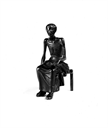Description
Artists of the Hellenistic age often depicted distortions of the Classical ideal or focussed on pathological states of the human body, such as this skeletal youth with a misshapen right foot. He is seated and seems bearly able to lift his left arm or keep his head raised. On the drapery around his lower body, two names are inscribed in punched letters: Eudamidas appears from knee to knee and may be the name of the person who commissioned the statuette. The name along the hem of the drapery, Perdik, has two literary associations, each of which casts the statuette in a slightly different light. It may refer to Perdix, a certain Athenian peddler, who had a club foot, and whose name had become synonymous with ailments of the foot. This explanation would correspond with the original function of such a small-scale bronze statuette--in ancient Greece, they were commissioned often as dedications to gods, offered at shrines either in gratitude for blessings received or as supplication by worshipers for divine favors, such as an athletic victory or healing. Eudamidas may have commissioned this piece as an offering to Asklepios, the Greek god of healing, for assistance with a foot problem.
On the other hand, Perdik may be an abbreviated form of Perdikkas, a young man who had neglected to sacrifice to Aphrodite while studying in Athens. As retribution, the vengeful goddess cursed him with a love for his own mother which caused him to waste away—a story that explains the combination of adolescence with the emaciated body. This option fits most comfortably with the adaptation of such a theme into an art object. The Romans had a particular admiration for Greek statuary and collected examples, either the originals. if available, or as copies, in different sizes and materials from the original.
- J. Hanson
Bibliography
Corpus Inscriptionum Graecarum (Berlin, 1828-1877), 6855b.
A. de Longpérier, "Figurine de Bronze du Cabinet de M. le Vicomte de Jessaint," Revue Archéologique I.2 (1844): 458-61, pl. 13.
For the "Aegritudo Perdicae", ascribed to Dracontius, see E. Baehrens, Poetae Latini Minores, Bibliotheca Scriptorum Graecorum et Romanorum Teubneriana (Leipzig, 1879-1930), 238-50.
A. T. F. Michaelis, Ancient Marbles in Great Britain, trans. C.A.M. Fennell (Cambridge, 1882), 629, no. 29.
S. Reinach, Répertoire de la statuaire grecque et romaine II.2 (Paris, 1898), 691.
C. H. Smith, "The Exhibition of Greek Art at the Burlington Fine Arts Club," Burlington Magazine 2 (1903): 255, pl. 4.
E. S. Strong, Exhibition of Ancient Greek Art, exh. cat., Burlington Fine Arts Club (London, 1904), 50, no. 50, p. xxvii, B50, pl. 52.
C. H. Smith and C. A. Hutton, Catalogue of the Art Collection, vol. 2: Catalogue of the Antiquities (Greek, Etruscan and Roman) in the Collection of the late Wyndham Francis Cook, Esq. (London, 1908), 109-111, no. 32, pl. 30.
W. Lamb, Greek and Roman Bronzes, The Illustrated Library of Archaeology (New York, 1929), 202-203, pl. 77a.
L. Goldscheider, Art without Epoch, Works of Distant Times Which Still Appeal to Modern Taste (New York, 1937), figs. 24-25.
"Dumbarton Oaks Research Library and Collection--Acquisitions December 1, 1946-November 1, 1947," Bulletin of the Fogg Museum of Art 10.6 (1947): 219-39, esp. 220.
G. M. A. Richter, Three Critical Periods in Greek Sculpture (Oxford, 1951), 32, fig. 57.
The Dumbarton Oaks Collection, Harvard University (Washington, D.C., 1955), 10, 24, no. 6.
G. M. A. Richter, Catalogue of Greek and Roman Antiquities in the Dumbarton Oaks Collection (Cambridge, 1956), 32-35, no. 17, pl. 14.
Handbook of the Byzantine Collection (Washington, D.C., 1967), 2-3, no. 6.
G. M. A. Hanfmann, A History of Western Sculpture, vol. 1: Classical Sculpture (Greenwich, Conn., 1967), 331, no. 250.
M. Robertson, A History of Greek Art (London, 1975), 558, 726 n. 143, pl. 179b.
A. P. Kozloff, D. G. Mitten, and S. Fabing, The Gods Delight: the Human Figure in Classical Bronze, exh. cat., Cleveland Museum of Art; Los Angeles County Museum of Art; Museum of Fine Arts, Boston (Cleveland and Bloomington, Ind., 1988), 18, 151-154, no. 25.
M. D. Grmek and D. Gourevitch, Les maladies dans l'art antique, Penser la médecine (Paris, 1998), 147-54.
G. Bühl, ed., Dumbarton Oaks: The Collections (Washington, D.C., 2008), 24, pl. p. 25.
D. Lippi and L. Verdi, Storia della Magrezza: Corpo, Mente e Anoressia, Explora (Fidenza (PR) [i.e. Parma, Italy], 2009), 26.
G. Adornato, "Aletheia/Veritas: The New Canon," in Power and Pathos: Bronze Sculpture of the Hellenistic World, ed. J.M. Daehner and K. Lapatin (Los Angeles, 2015), 367, esp. 53, fig. 3.3.
S. H. Carlos A. Picón, Pergamon and the Hellenistic Kingdoms of the Ancient World (New Haven, Connecticut, 2016), 163, no. 73.
S. Karasu, Of Epidemic Proportions: The Art and Science of Obesity, Sylvia Karasu (2019), 326.
R. Neer, Art & Archaeology of the Greek World, Thames & Hudson (2019), Fig. 14.34.
Acquisition History
Said to have been found in the Aisne River, near Soissons, France.
By 1844, collection of the Vicomte de Jessaint (1764–1853), Beaulieu, Trannes, France.
By 1874, collection of Frances Cook (1871–1901), London and Richmond Hill, Surrey, England.
By inheritance to his son, Wyndham Francis Cook (1860–1905).
By inheritance to his widow, Frederica Evelyn Stilwell Cook (1856–1925), London.
Sold at Christie’s, London, Cook Collection Sale (lot no. 32), August 1925.
Purchased at Christie’s by Joseph Brummer (1883–1947); Brummer Gallery, New York and Paris (inventory P2344).
Purchased from Brummer Gallery by Dumbarton Oaks Research Library and Collection, Washington, DC, August 1947.
Dumbarton Oaks Research Library and Collection, Byzantine Collection, Washington DC.



